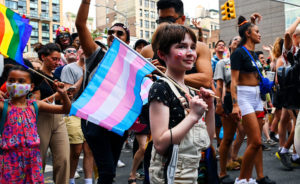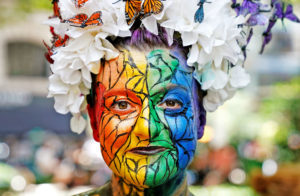Annie’s parents had spent so much time tending to her autistic brother that they hadn’t realised their daughter developed similar traits: a high IQ, a tendency to obsess, discomfort with her body.
Annie was diagnosed with epilepsy aged five. After puberty, she started to have “autistic meltdowns“. When the pandemic hit, she became obsessed with her weight and was eventually diagnosed with an atypical eating disorder.
Amid her mental health episodes, she discovered YouTube videos of girls identifying as trans boys. Whenever Annie was in crisis, she would assume a trans identity and then drop it once the emergency had passed.
But her crises worsened. She was hospitalised again and again. Both Annie’s parents and her private therapist explicitly told staff at each hospital not to affirm her transgender identity, which was so inconsistent that Annie didn’t meet the diagnostic criteria for gender dysphoria. “No one who spent time working with her outside of the hospital thought the real issue was that she had gender dysphoria,” her mother, Linda, said. But each hospital ignored their pleas.
After she had paid for Annie’s medical records from her seventh hospitalisation in 10 months, Linda discovered that Annie had not only been secretly affirmed and socially transitioned but encouraged to deceive her parents, who had been marked in the hospital records as unsupportive. This despite the fact that Annie had written on a worksheet that what she valued the most was her parents and that calls from them made her cry “tears of joy”.
The transition didn’t help. At the hospital, Annie got markedly worse, slamming her head into walls, scratching her arms until they bled, and hearing voices that told her to kill herself. She had to be physically restrained and injected with antipsychotics and Ativan.
But the staff, according to Linda, seemed concerned with little other than gender. As they prepared to transfer Annie to a residential mental health program, they asked her — without consulting her parents — if she wanted to stay in the boys’ or girls’ dorm.
***
Stories like Annie’s — of kids who are not getting mental health treatment because clinicians interpret their issues as being caused by gender dysphoria — are increasingly common in the United States. The problem is called “diagnostic overshadowing”, and it was one of the main reasons that the UK’s Tavistock gender clinic was shut down last month. As Dr Hillary Cass noted in her Interim Report, “[M]any of the children and young people presenting have complex needs… but once they are identified as having gender-related distress, other important healthcare issues that would normally be managed by local services can sometimes be subsumed by the label of gender dysphoria.”
Several parents I spoke to for this article told me their children were initially hospitalised for suicidal ideation, anorexia, and other mental health conditions. Once admitted, however, the children were diagnosed as suffering from gender dysphoria and encouraged to transition, often against their parents’ wishes. Their other mental health issues were then largely ignored.
Until recently, such mental health issues would have made therapists hesitant to facilitate transition for a young patient. The original Dutch protocol for treating adolescents with gender dysphoria, for instance, was based on research on patients with no serious comorbid psychiatric disorders. Although Dutch clinicians recommended the use of puberty blockers for certain patients, the children were not socially transitioned, which can increase the persistence of gender dysphoria.
But in recent years, concurrent with an exponential increase in gender dysphoria cases among teenage girls, the Dutch protocol has been overtaken by the gender-affirmative model. In this approach, “providers recognise, validate, and support the identity stated or expressed by the individuals served”, per the American Psychiatry Association. This means that clinicians are encouraged to facilitate social transition based on their patients’ self-diagnoses. In stark contrast to the kids from the original Dutch studies, however, the adolescents now presenting with “gender dysphoria” tend to have complicated mental health profiles.
In effect, the mental health profession has performed a U-turn. Whereas it was once understood that complex comorbidities such as depression, anxiety, or eating disorders might be the source of adolescent gender dysphoria, today, American doctors increasingly see it……. as the cause of all other comorbidities. Treat the dysphoria, the thinking goes, and the other conditions melt away.
***
A woman I’ll call Daria had entered her 17-year-old son into a psychiatric hospital treatment program for anorexia. Forty-eight hours later, while he was still on a feeding tube, a counsellor called to ask about her son’s gender issues. He’d never had any, Daria responded.
A week later, still barely eating, he was transferred to a residential programme. A counsellor there called Daria to say her son was actually her daughter and should start on oestrogen. Daria was sceptical, but the clinicians told her: “We have to address the gender or the anorexia just may never go away.”
Thus began a two-year battle to help her son with his most pressing problem — restricted eating — while resisting attempts by clinicians to redefine his problems as dysphoria. Family therapy sessions centered around pushing Daria and her husband to facilitate their son’s social and medical transition. “It became a lot more trying to convince us that our kid was transgender rather than working with us on how to support him in eating,” she said. Counsellors helped him pick stereotypically feminine clothing and settle on a stereotypically feminine name, but the eating struggles remained.
Daria, a scientific researcher, asked for evidence that cross-sex hormones would alleviate anorexia, but was given none. She asked about side effects. A therapist told her: “You need to stop focusing on the evidence and start focusing on your daughter.” Once her son turned 18, his residential programme helped him access hormones at a nearby Planned Parenthood. They didn’t help either.
“He had suicide attempts before he started hormones. He had a suicide attempt after he started hormones. And, you know, he restricted before he had hormones. He kept restricting after he had hormones,” Daria said.
Daria learned on her own that many people with disordered eating have an internal voice that demands they restrict. Eventually her son told her that his was a female voice, one that bullied him and demanded he make himself look like her.
When you work with somebody with anorexia, said Stella O’Malley, a psychotherapist in Ireland who works with gender-distressed children, “you talk about softening this voice and integrating this voice into the personality and figuring out where it’s coming from”. Therapists don’t affirm anorexics’ inner voice or desire for a specific body because anorexia nervosa has the highest mortality rate of any mental disorder; they try to help them make peace with the body they have. But with gender-dysphoric patients, that same clinical approach is considered “conversion therapy”.
The backbone of treating anorexia is having the family deeply involved, setting strong boundaries, and focusing on the behaviour. Once that is under control, the remaining problems can be addressed. With anorexia, body dissatisfaction is often the last thing to resolve, so what may appear to be gender dysphoria could be a lingering symptom of anorexia.
The diagnostic criteria for gender dysphoria and body dysmorphia are similar, too, but the treatment for the former includes affirmation and medical interventions, while the treatment for the latter is therapy. “Pretty much everything that they did once gender was introduced… was totally against the evidence that we know work for eating disorders,” Daria said. Lisa Marchiano, a Jungian psychotherapist, referred to this phenomenon as “gender exceptionalism” — the idea that “gender dysphoria gets treated different than any other mental health issue”.
But many believe affirmation is most likely to resolve dysphoria. “If it is all interconnected, then treating the gender dysphoria will likely also improve some of the other things that are happening,” says Sabra Katz-Wise, assistant professor in the division of adolescent and young adult medicine at Boston Children’s Hospital and a proponent of the affirmative model.
What should she do if it turns out that gender dysphoria isn’t the source of the problem? “I think it’s pretty rare that gender dysphoria is a symptom of something else other than being transgender or gender diverse,” Katz-Wise said. Yet in a study of 237 detransitioners — those who medically transitioned and regretted it — 70% reported “having realised that their gender dysphoria was related to other issues”.
Eventually, Daria found a private psychiatrist, who urged the staff at her son’s residential mental health facility not to engage with anything gender related. Only then, Daria reported, did her son start to eat.
***
At 12, Sofia’s daughter Constance, who had always been typically feminine, began suffering from anxiety, depression, and perfectionism, which she relieved through cutting. After a breakup with a woman she’d met online, Constance was hospitalised for suicidal ideation. She identified as bisexual, and then as non-binary, and continued with self-harm. She began smoking pot daily.
As her mental health worsened, Constance went to a 35-day stay in a psychiatric hospital in the northeast. “We didn’t feel like it had anything to do with the gender identity because she wasn’t really talking about that stuff,” Sofia said. “Even her therapist at home didn’t think that that was the issue.” Yet once the gender issues came up, “it just felt like every session became about that”.
From there, Constance was sent to an intensive outpatient program, where, within a week, she was using male pronouns. Sofia only found out when the therapist accidentally sent an email using he/him. Constance posted online that she wanted money for hormones, complaining that her parents wouldn’t pay. The doctors, Sofia said, “didn’t ask us anything about, well, what was their childhood like or do you know if there was any trauma or anything like that? It was just: Accept it. This is who he is now.”
But some clinicians interpret this research as licence to punish parents if they don’t affirm. At both the hospital and the outpatient programme, Sofia said, clinicians told her and her husband that if they didn’t affirm Constance, she would kill herself. “You bring your child there and then you become totally powerless,” Sofia said. “It always felt as though I was the last to know. And she had this group of adults supporting her and affirming her. So of course, we look like the bad guys because we never did [affirm her]. Our relationship was absolutely destroyed.”
Research does show that familial support is key to the mental health of LGBT kids. But that shouldn’t give clinicians licence to undermine parents if they want to assess rather than affirm. “I don’t think that driving a wedge between parents and children is going to help them,” said Caitlin Ryan, director of the Family Acceptance Project, which helps “ethnically, racially and religiously diverse families to support their LGBTQ children”. “I think working with parents and caregivers to increase support is one of the most important things we can do.”
The oppositional stance taken by Constance’s doctors, O’Malley says, is bad clinical practice. “It’s well-established in therapy circles that you try not to triangulate between parent therapist and child. It’s so destructive for the family unit, for the parent-child relationship, and for the actual the betterment of the child. And yet this triangulation is happening inevitably as soon as a clinic decides to not work with the family.”
Eventually, Sofia pulled Constance out of the programme and sent her back to her original therapist. There, she admitted that she had been sexually harassed and threatened in a chat room by a man who sent her nude photos. He told her if she didn’t send nude photos of herself, he would kill her family. “That’s when we really started to dive into why she was rejecting her femininity, why she was trying to take her power back,” Sofia said. Now in a residential facility, doing equine therapy and not focusing on gender, Sofia is finally doing well, her familial ties beginning to repair.
***
There are no easy answers for how to treat gender-distressed children. O’Malley advocates the “biospsychosocial model”, which is in essence a form of holistic care. It involves “looking at the body and the mind, looking at all the diagnoses, looking at how everything impacts — the cultural context, the family context, the internal biological context,” she says.
But she also knows that this cohort of kids with multiple and extensive multiple health issues needs a delicate yet exhaustive approach. “They are a very, very vulnerable cohort that need gentle and very cautious interventions,” she said. Clinicians shouldn’t leap to the conclusion that dysphoric kids are trans and need immediate social or medical transition to keep them alive.
Jack Drescher, clinical professor of psychiatry at Columbia University and section editor of the DSM-5-TR chapter on gender dysphoria, has no problem with the idea of affirming a child’s stated gender identity. He said it’s not necessarily the therapist’s job to contradict a patient’s subjectivity, to tell them they’re wrong, but rather to explore their perspective. But even he strongly believes in comprehensive evaluation.
“There are kids who will benefit from treatment and there are kids who will not benefit from treatment. And until we come up with a better way to decide how to distinguish between those two groups, then we’re going to be having these kinds of arguments,” Drescher says. “This is the biggest problem, to talk about the complexity of the subject. There is so much we don’t know.”
For some families, at least, it seems clear that affirmation is not the right approach. Linda told me that she and her husband called 16 facilities, searching for one that would treat Annie’s multiple mental health problems rather than fixating on her gender. “Almost every programme we called said that their official policy was to affirm,” she told me. “One programme told us that they affirm everyone so they don’t get sued.”
Eventually, however, they were able to transfer their daughter to a residential mental health facility in a Western state that was willing to look at her dysphoria as a symptom of her other issues, not the other way around. Annie is stable now, and her condition is slowly improving. Her family connection is restored. She lives in the girls’ dorm, and no longer identifies as transgender.
Disclaimer
Some of the posts we share are controversial and we do not necessarily agree with them in the whole extend. Sometimes we agree with the content or part of it but we do not agree with the narration or language. Nevertheless we find them somehow interesting, valuable and/or informative or we share them, because we strongly believe in freedom of speech, free press and journalism. We strongly encourage you to have a critical approach to all the content, do your own research and analysis to build your own opinion.
We would be glad to have your feedback.
Source: UnHerd Read the original article here: https://unherd.com/








